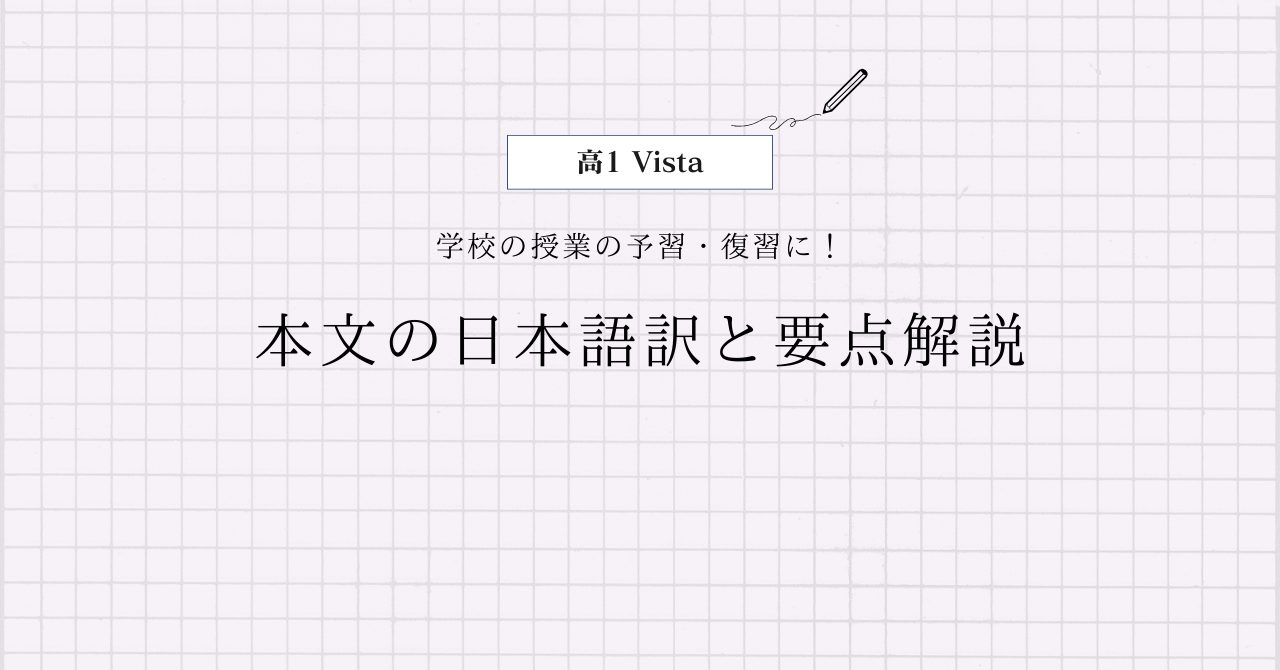三省堂 高1VISTA English CommunicationⅠ Lesson9 Section3の本文の日本語訳と重要箇所の解説です。
Section9-1, 9-2の解説はこちらからご覧ください。
>高1VISTA English CommunicationⅠ Lesson9 Section1 本文和訳
>高1VISTA English CommunicationⅠ Lesson9 Section2 本文和訳
- VISTA English CommunicationⅠ Lesson9 Section3 本文と日本語訳
- VISTA English CommunicationⅠ Lesson9 Section3 重要事項の解説
- Both Picasso’s Guernica and the children’s paintings show us the importance of peace.
- In “Kids’ Guernica,” children in over 50 countries have worked together to create colorful paintings and share a wish for peace.
- As they work, they learn to respect others who have different backgrounds in this world.
- Peace can exist in places where people respect each other regardless of race, religion and culture.
- VISTA English CommunicationⅠ Lesson9 Section3 まとめ
VISTA English CommunicationⅠ Lesson9 Section3 本文と日本語訳
Both Picasso’s Guernica and the children’s paintings show us the importance of peace.
「ピカソのゲルニカと子どもたちの絵はどちらも、私たちに平和の大切さを示しています。」
In “Kids’ Guernica,” children in over 50 countries have worked together to create colorful paintings and share a wish for peace.
「『キッズゲルニカ』では、50を超える国の子どもたちがカラフルな絵を作り、平和への願いを共有するために、一緒に作業しています。」
As they work, they learn to respect others who have different backgrounds in this world.
「彼らは作業しながら、この世界において様々な生い立ちの他者を尊重することを学びます。」
Peace can exist in places where people respect each other regardless of race, religion and culture.
「平和は、人々が人種や宗教、文化に関係なく、お互いを尊重するところに存在することができます。」

VISTA English CommunicationⅠ Lesson9 Section3 重要事項の解説
Both Picasso’s Guernica and the children’s paintings show us the importance of peace.
“both A and B”は「AとBの両方」という重要表現です。
“painting”は「絵画」、“importance”は「大切さ、重要性」、“peace”は「平和」という名詞になります。
名詞に‘sを付けると「~の」という所有を表しますね。
直前の名詞が複数形のときは” teachers‘ “のようにアポストロフィーだけを最後に付けます。
“show 人 もの”で「人にものを示す,見せる」となって,“show もの to 人”でも同じ意味になります。
In “Kids’ Guernica,” children in over 50 countries have worked together to create colorful paintings and share a wish for peace.
“over”は「~より多くの」という意味です。“more than~”も同じ意味があります。
ただし,人口や年月など元の数が大きい場合,つまりその数を含んでいるかが問題でない場合は「~以上」と訳してもOKです。
“work”は「作業する、取りかかる」という動詞で、ここでは「現在完了」が使われていますね。
“together”は「一緒に」という副詞になります。
“create”は「を創る、創造する」、“share”は「を共有する、分け合う」という動詞で、どちらも“to”と結びついて「不定詞の副詞的用法」になっています。
“colorful”は「カラフルな、色とりどりの」という形容詞で、“wish”は「願い」という名詞ですね。
As they work, they learn to respect others who have different backgrounds in this world.
“as”は「~しながら、~するにつれて」という接続詞です。接続詞“as”は5つの意味があるので、文脈に応じて訳を考えないといけません。以下に“as”の意味をまとめておきます。
“they”は“children”を指していて、“learn”は「を学ぶ、習得する」、“respect”は「を尊重する、尊敬する」という動詞です。
“to respect”は「不定詞の副詞的用法」になっていて、“other”は「他者」という名詞ですね。
“who”は「主格の関係代名詞」で、“who have different backgrounds in this world”が先行詞“others”を修飾しています。
“different”は「異なった、様々な」という形容詞、“background”は「背景、生い立ち、経歴」といった名詞です。
Peace can exist in places where people respect each other regardless of race, religion and culture.
“exist”は「存在する」という動詞です。
“where”は「関係副詞」で、“where people respect each other regardless of race, religion and culture”が先行詞“places”を修飾しています。
“each other”は「お互い」、“regardless of~”は「~に関係なく、~にかかわらず」という重要表現になります。
“race”は「人種」、“religion”は「宗教」、“culture”は「文化」という名詞ですね。
VISTA English CommunicationⅠ Lesson9 Section3 まとめ
以上がVISTA English CommunicationⅠ Lesson9 Section3の日本語訳となります。
「関係詞」「不定詞」などの使い方をしっかり確認しておきましょう!
>高1VISTA English CommunicationⅠ Lesson9 Section1 本文和訳
>高1VISTA English CommunicationⅠ Lesson9 Section2 本文和訳
何か分からない点や他に解説してほしい点があれば,お気軽にコメントしてください!



コメント